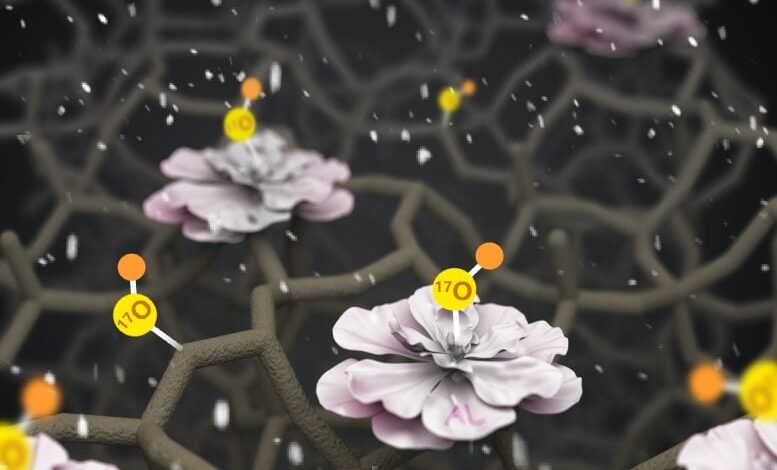Scientists Uncover Atomic-Scale Insights Into Zeolites


A new study has enhanced the structural analysis of zeolites, offering insights into their catalytic mechanisms and potential broader applications in material science. Credit: DICP
Researchers at the Dalian Institute of Chemical Physics have advanced the analysis of zeolites using innovative 17O solid-state NMR techniques, revealing the intricate structures of hydroxyl groups and improving our understanding of their catalytic properties. This breakthrough could have wider applications in analyzing other complex materials.
Zeolites are extensively employed across various industries, yet the complete comprehension of their intrinsic catalytic properties remains elusive, largely due to the complexity of hydroxyl-aluminum moieties.
Atomic-scale analysis of local environments for the hydroxyl species is essential for revealing the intrinsic catalytic activity of zeolites and guiding the design of high-performance catalysts. However, many unfavorable factors prohibit the elucidation of their fine structures such as low quantity, meta-stable property, structural similarity, hydrogen-bonding environment, and long-range disordered nature.
Recently, a research team led by Prof. Hou Guangjin and Prof. Chen Kuizhi from the Dalian Institute of Chemical Physics (DICP) of the Chinese Academy of Sciences (CAS) unraveled the precise structure of complex hydroxyl groups in zeolites with a comprehensive set of self-developed coupling-edited 1H-17O solid-state nuclear magnetic resonance (NMR) methods. The study was published in the Journal of the American Chemical Society.
Advancements in 17O Solid-State NMR
The 17O solid-state NMR would be a candidate to improve the analytical precision of zeolites if it could overcome the technical difficulties related to the extremely low natural abundance, low gyromagnetic ratio, and quadrupolar nature of the 17O isotope. Therefore, researchers employed a novel 17O-enrichment method and developed a series of 17O-NMR-based spectral editing pulse sequences, allowing them to improve the spectral resolution and address the subtle protonic structures within zeolites.
The precise and high-resolution species identification was attributed to comprehensively addressing an often-neglected and undesired NMR interaction, namely, the 2nd-order quadrupolar-dipolar cross-term interaction (2nd-QD interaction), which was indeed helpful in gaining invaluable information on zeolite structures.
Besides, researchers quantitatively probed Al···H, O···H proximities within both one-bond and multi-bond ranges, and semi-quantitatively realized the dissociation rates of hydroxyl protons such as BrØnsted acid site. They revealed the atomic-scale local environment of the catalytically important Al-OH and Si-OH moieties.
The NMR techniques developed in this study might be further applied in providing high-resolution analysis of subtle protonic structures in other circumstances such as metal-oxide surfaces, metal-organic frameworks, and biomaterials. “Our study may provide a generic strategy for high-resolution analysis of the subtle protonic structures in zeolites with 17O solid-state NMR,” said Prof. Hou.
Reference: “Precise Structural and Dynamical Details in Zeolites Revealed by Coupling-Edited 1H–17O Double Resonance NMR Spectroscopy” by Yi Ji, Kuizhi Chen, Xiuwen Han, Xinhe Bao and Guangjin Hou, 26 March 2024, Journal of the American Chemical Society.
DOI: 10.1021/jacs.3c14787



